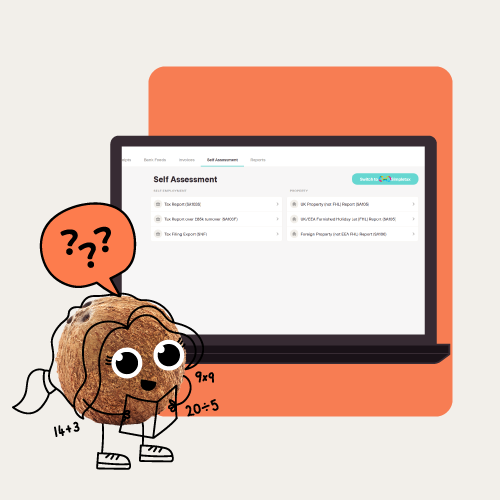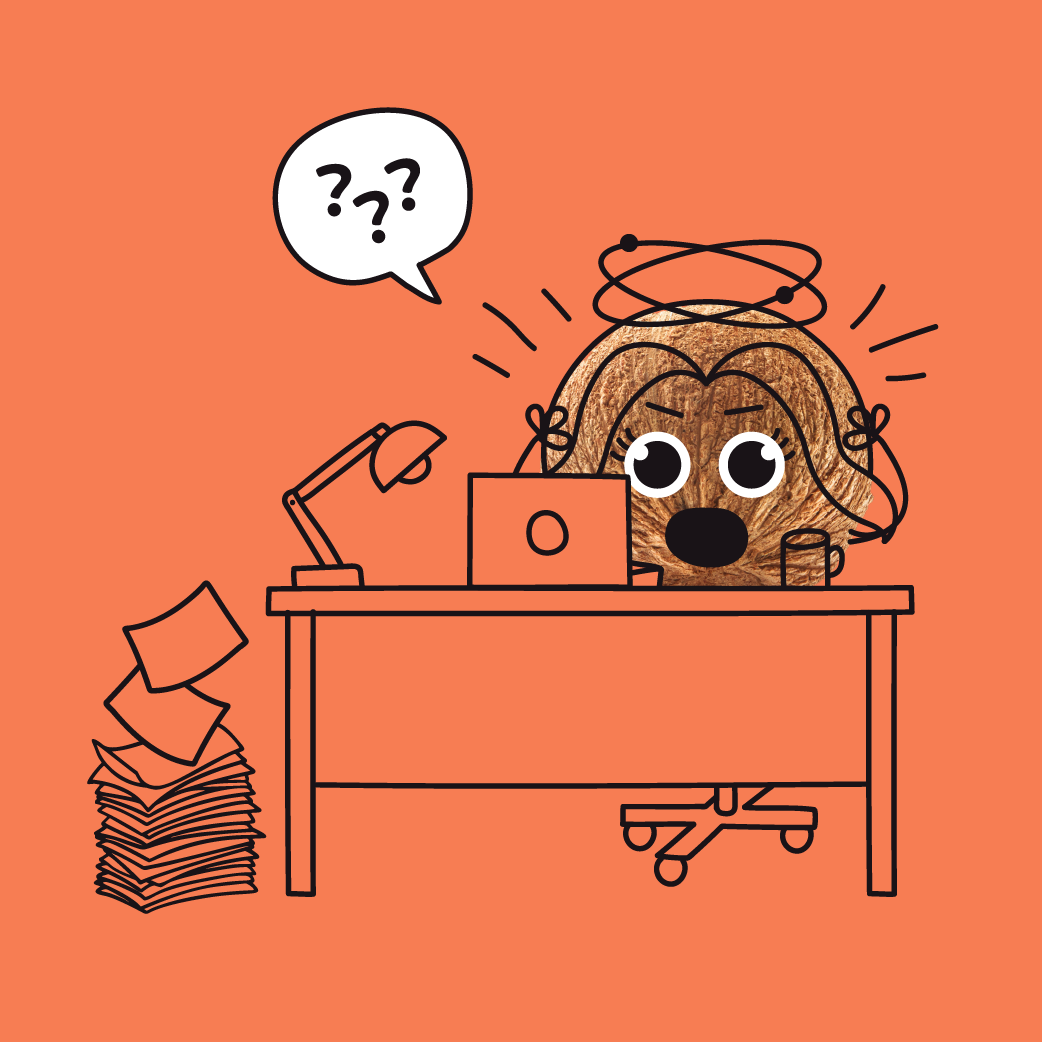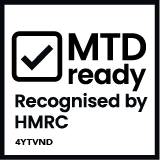Are you ready for Making Tax Digital—or still trying to get your head around it? The way sole traders record income and expenses and submit details to HMRC is about to change—which can feel a bit daunting. But don’t worry: we’re here to explain everything you need to know about MTD for Income Tax.
Before we start...
If you're feeling uncertain about your finances, we recommend you work with an accountant. Having an accountant is valuable beyond just compliance and tax planning—it’s about having someone by your side with the experience to help you make the big decisions and build a better business.
Coconut also makes it really easy for you to collaborate with your accountant. Once you've invited yours through the app, they'll be able to view your business activity and bookkeeping data whenever they need to.
What is Making Tax Digital for Income Tax?
Making Tax Digital (MTD) is a government-led initiative, designed—in theory—to make tax admin simpler for taxpayers. They started with Making Tax Digital for VAT in 2019 and they’re now moving on to Income Tax.
MTD for Income Tax Self Assessment (MTD IT or MTD for IT) marks the end of the annual tax return as we currently know it, and in its simplest form, is a new way of reporting your earnings to HMRC on a more regular basis.
Practically though, it means a lot more work for sole traders—as you’ll now need to submit details of your income and expenses to HMRC four times a year, instead of one.
That’s a lot.
But here at Coconut, we’re dedicated to making the transition as painless as possible, and to supporting self-employed people through this change.
And maybe even making bookkeeping enjoyable along the way!
Does Making Tax Digital apply to self-employed people?
Yes. Making Tax Digital for Income Tax applies to sole traders and those who make an income from property, which means that anyone who’s self-employed but doesn’t operate through a limited company will have to sign up and use the new system.
Do I have to use Making Tax Digital for Income Tax?
If you’re a sole trader or landlord, and your income from those sources is over £50,000 per year before tax, then yes, you’ll have to sign up for MTD for Income Tax when it’s rolled out in 2026. Those who earn more than £30,000 will then also be mandated to meet MTD requirements from 2027 and those who earn more than £20,000 will be mandated from 2028.
What is the deadline for Making Tax Digital?
Making Tax Digital for Income Tax Self Assessment will come into effect for all sole traders (and landlords) earning over £50,000 per year on 6th April 2026, those earning over £30,000 on 6th April 2027 and if you earn over £20,000 from 6th April 2028.
Has Making Tax Digital been delayed?
Yes: Making Tax Digital for Income Tax was originally set to come into effect in April 2023. But in September 2021, the government announced that, in light of the pandemic, the rollout for sole traders would be delayed by 12 months to April 2024. Then in December 2022, HMRC delayed it by a further two years: the first phase is now due to come into effect for those with self-employment and property income of more than £50,000 in April 2026, with those earning more than £30,000 following in April 2027 following that, £20,000 in April 2028.
How will digital tax work?
Making Tax Digital is supposed to simplify tax for self-employed people—but at first glance, it does look like there will be more admin involved than just one annual Self Assessment tax return, which is your only obligation under the current system.
Here’s what MTD for IT will mean for sole traders:
1. You’ll have to use a digital product to track income and expenses
While many choose to do this already, keeping digital records of all your business income and expenses will become a requirement from the Making Tax Digital start date in April 2026.
You can’t just use any old software though; it needs to be HMRC-recognised, and compatible with MTD. So if you’re already using Coconut, you’re one step ahead!
2. You’ll have to submit your income and expenses four times per year, instead of one
Every three months, you’ll need to send a summary of your business income and expenses to HMRC. Coconut will help you keep on top of this and let you know when it’s time for another update.
After you’ve sent an update, you’ll then be able to see a year-to-date calculation of how much tax you owe based on the information you provide.
3. You’ll need to send an end of period statement at the end of the tax year
This is where you finalise your total business income and expenses for the year as a whole—essentially confirming that the quarterly updates you sent throughout the year are correct. It also gives you an opportunity to make any adjustments if you need to, and make HMRC aware of any personal income you have or reliefs you want to claim.
4. You’ll also need to submit a final declaration at the end of the year
At the end of the year, you’ll also have to submit a final declaration, which basically just confirms the information you’ve given in your end of period statement. This replaces the Self Assessment tax return under the current system, and the deadline for it is the same: 31st January in the year following the tax year you’re declaring for.
So for example, when you submit your final declaration for the tax year 2026–2027, the deadline will be 31st January 2028. This is also the date by which you’ll have to pay any tax you owe.
Preparing and signing up for MTD for ITSA
Confused about the how, when, and why of preparing for Making Tax Digital? We’ve got you covered.
When do I need to start preparing for Making Tax Digital?
If you earn more than £50,000 from self-employment or property, you need to be signed up for MTD by 6th April 2026. That might seem like a long way away, but you do need to start planning for it now. It’s a big change and it will take some getting used to.
If you already use a specialist sole trader accounting tool like Coconut, then you’re off to a good start. But if you’re working from homemade spreadsheets or straight up pen and paper, then you might want to start testing the waters.
The sooner you start getting into the right habits around digital bookkeeping, the more comfortable and familiar you’ll be with it when the time comes.
Want to test it out? You can try Coconut for free for 30 days.
Can my accountant sign up for me?
Yes, your accountant can sign up for MTD on your behalf and will be able to submit your quarterly updates, end of period statements, and final declarations for you too. You’ll need to provide them with all the information they need to sign up, so make sure you speak to them about this ahead of time. They’ll also have to send you a unique link where you can log in with your Government Gateway ID and password to give them permission to send your returns for you.
Also, even if your accountant is handling the admin for you, you’ll still need to follow the rules brought in by MTD by keeping digital records of your income and expenses. You’ll also need to make sure that the software you use works with what your accountant uses.
With an app like Coconut, for example, you can invite your accountant to view your account activity and bookkeeping data through the app, and they’ll have everything they need to prepare your (digital) paperwork for you—that means no more frantic back-and-forth emails at tax time.
Digital record-keeping and reports
Ok, so you understand the basics—that you’ll have to submit four reports of your income and expenses instead of one, and a final statement at the end of the year.
But how will digital record-keeping and submitting your reports via an app actually work?
What software do I need for Making Tax Digital?
To use Making Tax Digital, you’ll need to keep records and send your information to HMRC using accounting software. HMRC have not made this software themselves—instead, they’ve created an Application Programming Interface (API) that allows developers of accounting and bookkeeping software to connect their programs to HMRC.
In layman’s terms, this means that you’ll have a limited number of applications to choose from, which are compatible with MTD. You’ll use this to keep a record of your income and expenses and submit these digitally to HMRC.
At Coconut, we’re already HMRC-recognised for handling MTD ITSA digital record-keeping and quarterly submissions requirements and will be ready for Making Tax Digital once it comes into play in 2026.
Can I use Excel for Making Tax Digital?
If you’re still using Excel to track your finances, you can continue to do so after MTD comes in—but we don’t recommend it. The reason is that you’ll have to use ‘bridging software’ to transfer your data from Excel into HMRC’s system.
And in our humble opinion, if you’re going to be downloading, installing, and learning how to use a new piece of software anyway, it might as well be one that you can use to track your finances, send invoices, and capture your receipts and records all in one place (like Coconut, for example 😉)
What records do I need to keep?
Under Making Tax Digital, you’ll have to keep records of all incoming payments and expenses for your self-employment or property business. These records need to be kept in an MTD-approved app. Since you’ll be able to use this app to transfer this information to HMRC each quarter in just a few taps of your screen, this change will likely make managing your finances easier.
Depending on the app you choose, you might be able to connect to your bank accounts and credit cards so that transactions will automatically be imported into the software. If you need to enter information manually, you need to do this as close to the time the transaction took place as possible, and before you submit your next quarterly report.
When will I have to make my first quarterly report?
The deadline to sign up for MTD for Income Tax is 6th April 2026. Once you’re signed up, you’ll have to send a report to HMRC every quarter. You’ll have a month after the last day of the quarter you’re reporting for to send your report.
To make that a bit clearer, here are the dates you’ll have to submit your reports each year:
This means that your first quarterly report will cover the period 6th April–5th July 2024, and will be due by 5th August 2024.
Alternatively, you can opt to submit an update for each ‘calendar quarter’, which means you’ll report for three full months each time instead of the 6th through to the 5th of the month. If you choose this option, the deadline for filing your report will be the same as above—and your calendar for the year will look like this:
Making Tax Digital for Income Tax: your FAQs answered
Still got questions? Here are the answers to some FAQs about MTD for ITSA.
Who is exempt from Making Tax Digital?
In the vast majority of cases, any sole trader or unincorporated landlord earning more than £20,000 per year will have to sign up for MTD over the next few years. However, there are exceptions in very specific circumstances, when you may be granted an exemption.
Specifically, you can request an exemption if you’re not able to use a computer, the internet, or software. This could be for religious reasons, or because of:
- Your age
- A disability
- Where you live
- …or any other reason that makes it impractical and unreasonable for you to use an accounting software tool for your taxes.
Since you’re reading this blog post, there’s a good chance this doesn’t apply to you—but if it does, you or your accountant will need to contact HMRC to ask for an exemption.
Can I opt out of MTD if I earn below the income threshold?
Unless you’re exempt, you’ll have to sign up for Making Tax Digital from 2026 if you make more than £50,000 per year from self-employment or property, 2027 if you earn more than £30,000 and 2028 if you earn more than £20,000.
HMRC has not offered any clarity on whether individuals will be able to opt out of MTD if their income drops below the threshold—or whether those earning less than this amount will be able to sign up voluntarily.
They’ll likely release guidance on this closer to 2026—so watch this space, and we’ll let you know when we know!
Will I still be able to file paper returns?
If you’re registered for Making Tax Digital, your tax information will need to be submitted digitally. If you earn under the threshold, MTD doesn’t apply to you, so it’s likely that you’ll be able to continue filing paper returns if you like.
Do I need to digitally store receipts and invoices?
No—you can still keep your paperwork on paper if you want to. However, each transaction needs to have a digital record attached to it, and the amount concerned needs to be allocated to the correct income or expense category within your accounting software. The total amount in each of these categories (and not individual transactions or scanned receipts) needs to be submitted to HMRC each quarter.
Can I still send handwritten or printed invoices?
Yes, you can still create handwritten invoices or print them out to send to your clients under MTD. They just have to either:
- Already form part of your digital records, i.e. an invoice you’ve created in your accounting software and printed to send to a client
- Be added to your digital records as soon as possible after the transaction
Bonus tips to prepare for MTD for ITSA
2026 might seem like the distant future at this point, but trust us: it’ll be here before you know it.
It’s a good idea, then, to do everything you can to prepare for Making Tax Digital for ITSA ahead of time, to avoid any unexpected problems when the time comes. Here are a few tips to make sure you’re prepared:
Work out whether you need to sign up
To avoid any last-minute stress, it’s a good idea to find out if you need to sign up for MTD before the deadline comes around. It’s easy enough to find out. If you’re a sole trader and you earn over £50,000 per year (before tax) from your sole trader or rental income (or a combination of both), you’ll have to sign up by 2026—or by 2027 if you earn over £30,000.
Plan to sign up ahead of time
If you do need to sign up, the deadline will be 6th April 2026 or 2027 (depending on your income). However, it’s a good idea to plan ahead and sign up before this date, to make sure there’s no chance of missing it!
HMRC is currently running a pilot scheme, so you can actually sign up voluntarily already if you want to. However, there are only a limited number of software options available at the moment.
Optimise your admin processes
Making Tax Digital could be a great opportunity to review your business admin processes and make sure they’re as efficient as possible. OK, this isn’t a very exciting prospect—but if you’re still using spreadsheets (or, god forbid, pen and paper) to record your income and expenses, now might be a good time to take the leap and find an easier, more modern solution.
And on that note…
Get used to using accounting software
Making Tax Digital for Income Tax won’t be mandatory until 2026, which means that you don’t need to start using accounting software to keep digital records until then.
However, it’s never a bad idea to be prepared, and you can take the first step towards being MTD-ready by signing up for some simple accounting and tax software today—you never know, it might make your life easier in the meantime!
Coconut is an easy-to-use, intuitive app for busy sole traders and landlords that you can use to understand your money, send and track professional, branded invoices, and even give your accountant access to your data so you can stop wasting your time with emails.
Interested? Give Coconut a try with a 30-day free trial.











